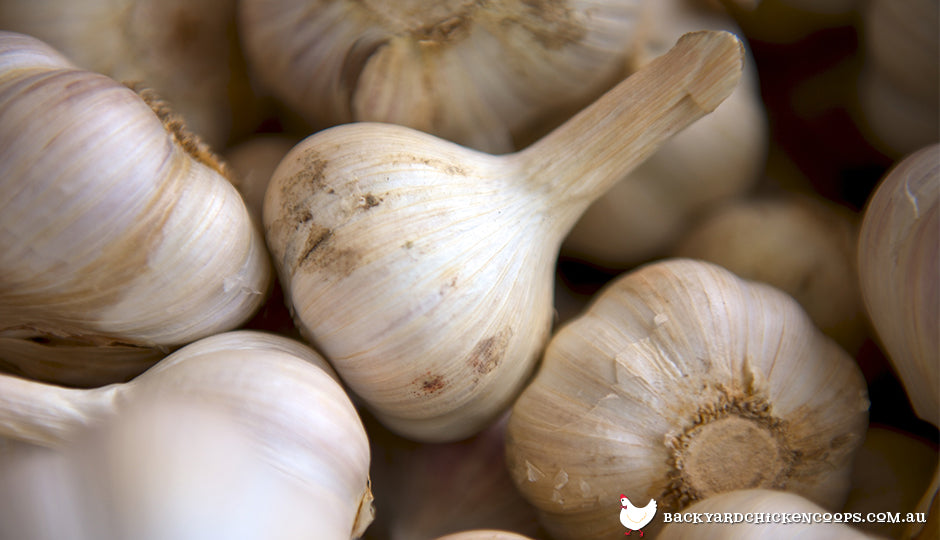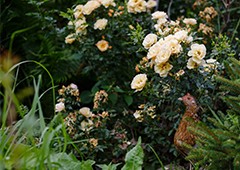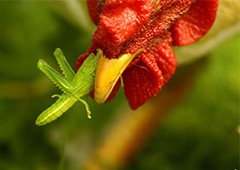There is a sense of mystery and mythology surrounding garlic. When we first think about garlic we might initially imagine golden brown loafs of buttery garlic bread, but soon enough our minds might turn to images of vampires and witch doctors. It’s hard to think of another plant that is equally as delicious and intriguing as garlic. Not only is it a popular ingredient in many types of cuisine, from Italian to Chinese, to the most ludicrous American guilty pleasures, it also carries with it interesting stories, myths and superstitions, which only contribute to creating a most delectable experience.
What is garlic?
Some people believe that when Satan first stepped onto the Earth garlic sprang from the soil beneath his feet, however more commonly today it is accepted as a member of the allium family, which also includes leeks, shallots and of course onions. Sometimes referred to as ‘the stinking rose’ it is a popular ingredient that has a strong, heated and pungent flavour when served raw, which mellows and sweetens when cooked. Garlic commonly grows in a bulb underground, which develops smallish crescent cloves that are encased in papery jacket.
Are there different types of garlic?
As is the case with most popular vegetables that are indeed many different types of garlic, which can ultimately be divided into two main categories…
Softneck Garlic: Softneck garlic is probably to most common varieties of garlic available on the market. This variety produces between eight to twenty cloves per bulb generously encased in a papery like skin that helps prolong its shelf life. Common Australian varieties include Printanor, Australian White, Californian Late and Italian White.
Hardneck Garlic: Hardneck garlic is visually quite distinct from soft necks, due to the fact it has a firm flowering stem, which grows out of the centre of the bulb. Additionally, Hardneck garlic tends to produce larger yet fewer cloves and tends to have a milder flavour. Common varieties include Italian Pink, Grenlarge and Russian Garlic.
There are so many more varieties of garlic out there, each with its own unique look and particular flavour, so keep an eye out for interesting varieties that you might want to eat or even grow in your garden.
Is it true that garlic is medicinal?
Garlic was broadly used in folk medicine to treat things such as the common cold, flus and even the plague. Pagans also were drawn to the mystical powers of garlic often using it in rituals to guard themselves against dark and malevolent forces. Garlic is still used today to help boost the immune system, due to the fact it is a strong natural source of allicin and diallyl sulphides. It is still commonly consumed in larger quantities or in supplement form at the onset of a cold or flu to help fortify the body. It is also believed that garlic can manage blood pressure, cholesterol, as well as being a pseudo-sedative for insomniacs and also lifting the spirits of those who might be having trouble with their libido. At the end of the day however most people tend to eat garlic simply for its great taste!
Can my chickens eat garlic?
Garlic actually has amazing benefits for chickens! When chickens eat garlic it actually help their bodies repel and resist pests such as mites, lice and worms, in a similar way to apple cider vinegar. This is in large part due to the high sulphur content in garlic that naturally is repellent to these kinds of pests and parasites. The sulphur begins to permeate through the poultry’s skin, which in turn deters all sorts of nasty critters from bothering them. There is some concern that is chickens consume too much garlic it can result liver damage. There really is no need to worry though because most chickens will instinctively know how much is too much.
When is the best time to grow garlic?
The popular myth is that garlic should be planted on the shortest day of the year, otherwise known as the winter solstice. Though this is a nice idea, it isn’t necessarily compulsory or essential. Ideally garlic should be grown when the monthly temperatures range between 13-24 degrees Celsius. This means that April through to July is the best time to plant a few cloves in your backyard. Hardneck varieties tend to have more success in colder environment compared to softnecks, so it’s best to assess the conditions in your backyard before you select which type of garlic you are going to plant.
How do I plant garlic?

Not everybody knows that garlic cloves are actually the “seeds” of the garlic plant. So, in order to grow your own garlic at home you simply need to individually plant each garlic clove with the root end facing down and the pointy end facing up. Plant garlic in fertile, well-drained loamy soil that has a PH between 5.5 and 7 that also gets plenty of sunlight and lots of air. Ensure that each clove is planted 25 mm deep, with 100 mm distance between each plant and that each row is at least 450 mm apart. Though it’s essential to water the cloves upon first planting them, be cautious of over watering, as garlic and water are simply not best friends. Supermarket bought garlic cloves do not always grow as well, so be sure to purchase organic or more specialist varieties from either a farmers market or gardening guru.
What to do while the garlic grows?
Garlic takes approximately 17 to 25 weeks to grow before it can be harvested, so there’s plenty of time for your mouth to start watering in anticipation! You are going to need plenty of distractions while you wait for your sweet and spicy bulbs of goodness to bloom. Here are some things you can do while you wait…
- Water your garlic regularly in the beginning, but once the plant begins to flower pull back to only once every 3 to 5 days. Remember, garlic and water are not best friends.
- Garlic requires plenty of nitrogen towards the end of its growth so be sure to fertilize your plants with plenty of chicken manure rich compost.
- Garlic absolutely loves mulch, as it cools the soil, protects the plants and it also helps prevent weed growth.
- Keeping weeds at bay is vital as garlic has a large appetite and won’t enjoy the competition.
- Plant garlic alongside other fruits and vegetables like beetroot, tomatoes and lettuce, but avoid planting other allium family plants, like chives and spring onions – peas and beans are also a no-no.
- When harvesting Softneck and Hardneck garlic wait for the leaves on the flower to begin to wilt before digging up the garlic to test if it has grown successfully.
Compared to some other plants garlic definitely takes a little longer to mature, but once you roast your first fresh organic clove you’ll remember what all the effort was for.
How do I roast garlic?

The smell of roasting garlic is absolutely irresistible. Whether you like to roast garlic as a simple spread alongside a roast dinner, to store it as an ingredient for other recipes or simply to enchant your guests with its intoxicating smell – it’s easy to find a reason to chuck a few bulbs into the oven every time you’re cooking. Here is a simple guide to help you roast your own garlic at home…
- Pre-heat your oven to 180-200 degrees Celsius.
- Peel most of the papery skin off the garlic and trim the head.
- Drizzle a healthy amount of olive oil over each bulb of garlic.
- Wrap each bulb in aluminium foil.
- Roast in the oven for at least 40 minutes.
- Pierce the garlic with a skewer to check that the cloves are soft and smooth.
- Leave in the oven for longer if you want sweeter and more caramelised flavours.
Be sure to store roast garlic in the fridge for up to two weeks, if you want to enjoy its unique, sweet and moreish flavour for longer. Substituting regular garlic with roast garlic when cooking is an easy way to give an old family favourite a tasty twist.
How else can you use garlic in cooking?

Garlic is perhaps one of the most popular ingredients in so many different types of cooking. Even the Pharaohs in ancient Egyptian times would feed the slaves garlic to help fortify their strength as they built the pyramids. Though raw garlic might be tasty for some, it’s always a nice idea to treat yourself to some of more the indulgent garlicy meal ideas. Here are some delectable ways to use plenty of garlic in your cooking…
- Roast garlic and bacon guacamole.
- Garlic chocolate truffles.
- Garlic cheesy bread.
- Garlic, rosemary and chili almonds.
- Garlic and thyme quinoa patties.
This being said, sometimes garlic is simply the best when served in pizza or pasta or mixed through a stir-fry. There is always a reason to include garlic in almost any meal – so be sure that you have plenty of bulbs at the ready in your pantry or growing in your garden.
Garlic is simply great for all sorts of things, from warding off vampires to making a tasty entrée. Chickens are the perfect companions when it comes to growing garlic, as they will not only savour the flavour and health benefits like you do, they are also great natural gardeners who will help your bulbs flourish. Stop dreaming about garlic - even though that’s technically a good omen - plant some cloves today and start reaping the benefits.
From plants to chicken runs, there are plenty of things to consider when becoming a chicken parent. We all want to be the best for our chooks! However, many chicken keepers struggle to handle chicken health or behaviour issues, especially in the first few years of having a flock.
This is why I recommend Chickenpedia to all my readers. They have comprehensive online courses on everything you didn’t know you need to know and then some more! From healthcare to raising baby chicks to feeding and behavior, you’ll find beginner-friendly courses that’ll give you the knowledge and confidence to successfully look after your chickens.
As a member, you will get access to ALL their fantastic courses. No need to wing it, become the ultimate chicken eggspert! Check out Chickenpedia today!
Also, be sure to check out our Taj Mahal, Penthouse and Mansion coops, which will be the perfect safe haven for your hard working garden chooks!


















